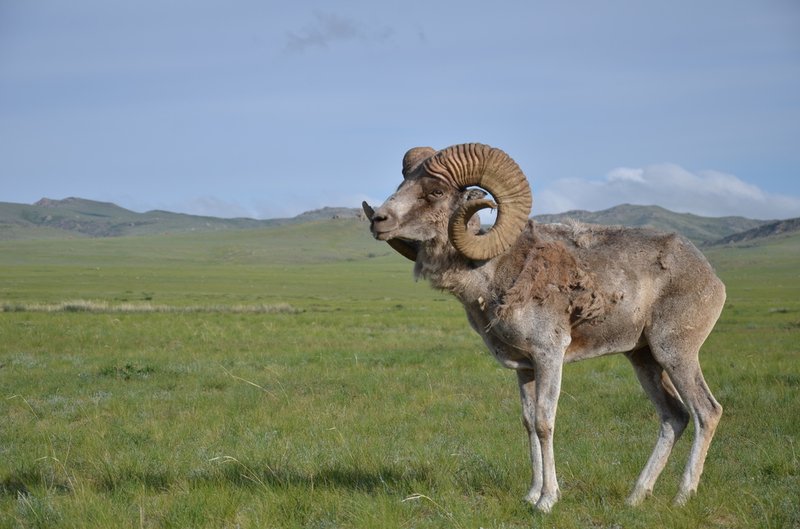
The Argali (Ovis ammon) is the largest wild sheep species and can weigh up to 400 pounds. They thrive in harsh environments, such as the Mongolian steppes and the Tibetan Plateau. Imagine these magnificent animals hopping through rocky terrain, their large frames seemingly effortless against the backdrop of jagged mountains. However, while they may look majestic and peaceful, their strength and wild nature can sometimes make interactions with humans tense and, in rare cases, dangerous.
But how often do such dangerous encounters occur? Are Argali as fierce as they seem, or are they just misunderstood? Let’s break down what you need to know about these beautiful animals and discover whether they can truly be a danger to us.
Understanding the Argali’s Nature
Argali sheep are primarily known for their unique physical traits, like their impressive horns and agility. These horns can grow up to 6 feet long in males! Beyond their looks, it’s important to understand their natural instincts and behaviors. Generally, Argali are shy creatures that prefer to keep to themselves, often moving in herds for safety.
Social Behavior: Argali form groups, typically composed of females and their young. Males, especially during mating season, can become solitary or form bachelor groups. Their social structure encourages an environment where they are more focused on survival than confrontation. You might be wondering, why does this matter? Well, their tendency to flee from danger means they usually avoid conflict with humans. However, when cornered or threatened, their natural instincts take over.
Habitat Influence: Living in rugged, high-altitude areas, Argali have adapted to a harsh lifestyle. They are amazing climbers, often navigating steep cliffs with ease. This adaptability makes them less likely to encounter humans regularly, as they prefer remote, open spaces. Essentially, their habitat reduces the chance of close human interactions, which is a good safety measure for both parties.
When Are Argali Dangerous?
While Argali generally avoid confrontation, they can be dangerous under specific circumstances. For instance, if a human unexpectedly approaches a herd, the sheep may feel threatened and react defensively. This defensive behavior can lead to an aggressive stance or charging, especially during the rutting season when males are more territorial.
Defensive Behavior: If an Argali feels cornered or sees its young at risk, it might not hesitate to defend itself. Imagine a mother protecting her lambs—she’ll do whatever it takes. In these moments, their massive size and strength could indeed pose a danger to an unsuspecting hiker or observer.
Unfortunate Encounters: While rare, there have been reports of aggressive behavior in areas where Argali are hunted or feel their territory is encroached upon. Hunting pressures can change their natural behavior, making them more skittish or defensive. This can lead to unpredictable encounters with humans, but such situations are typically avoidable with respect for their space.
Common Myths About Argali
When it comes to wildlife, myths often cloud facts. The Argali is no exception. Many people might think of them as ferocious beasts ready to charge at any human. However, that’s far from the truth.
Misinformation About Aggression: A common misconception is that these sheep are naturally aggressive. In reality, they prefer to escape danger rather than confront it. Most encounters with humans result from their surprise rather than any inherent desire to attack.
Comparison with Domestic Sheep: Argali are much less domesticated than common sheep. Their wild nature makes them more unpredictable. In contrast, domestic sheep have been bred for gentleness. This difference highlights just how important it is to approach wild animals with caution and respect.
Staying Safe in Argali Territory
If you’re planning to visit areas where Argali are known to roam, it’s crucial to take some safety precautions. Here are a few tips:
- Maintain Distance: Always observe from a distance. Using binoculars can enhance your view without intruding on their space.
- Stay Calm: If you spot an Argali, remain calm and silent. Sudden movements may startle them and provoke a defensive reaction.
- Don’t Approach: Never try to get closer for a better photo. Respect their boundaries and the wildlife rules of the area.
- Travel in Groups: There’s safety in numbers. If you’re outdoors and come across Argali, traveling in a group can help minimize any perceived threat.
By following these precautions, you can enjoy witnessing these extraordinary creatures without putting yourself or the animals at risk.
Ultimately, the Argali is a remarkable animal that plays an essential role in its ecosystem. While there is the potential for danger in specific situations, they are generally not aggressive towards humans and prefer to keep their distance. By respecting their space and observing them from afar, you can appreciate their beauty without fear.
So, next time you think about the potential danger posed by wildlife, remember the Argali. They might seem fierce, but like many animals, they just want to live their lives in peace. Let’s admire them for their grace and strength, while also ensuring we coexist respectfully in their habitats.

